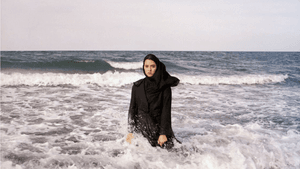Stay in the Loop
BSR publishes on a weekly schedule, with an email newsletter every Wednesday and Thursday morning. There’s no paywall, and subscribing is always free.
Twelve provocative photographers from Iran and the Arab world
National Museum of Women in the Arts' She Who Tells a Story

Washington D.C.’s National Museum of Women in the Arts (NMWA) — the only museum in America devoted solely to exhibiting art by women — opened 30 years ago. Yet each time I visit, I’m struck by how few visitors this majestic, Renaissance-revival-style museum attracts. Whether this is due to its location, some distance from the Smithsonian complex on the National Mall, or because (unlike the Smithsonian) it charges an admission fee, I don’t know.
What I do know is that it’s road trip season here in Philadelphia, and having this former Masonic Temple all to oneself can be a beautiful thing. NMWA offers an appropriately contemplative space in which to absorb the museum’s current show, She Who Tells A Story, a travelling exhibition of twelve contemporary female photographers from Iran and the Arab world.
The show has two entrances, one reached by mounting a sweeping marble and granite staircase, the other by crossing the cavernous Great Hall and taking an elevator. Whichever way you enter, you’re met by the arresting images of Tehran-born photographer Newsha Tavakolian. Her “Listen” series depicts professional Iranian women singers; female singers are forbidden to perform in public.
The sounds of silence
Tavakolian has somberly draped her subjects in black dress and hijab, and captured their beauty through a series of images in which each woman is photographed mid-song, eyes closed, against a dazzlingly bright sequined background. She also filmed these same women passionately singing, but the recordings are silent. At the conclusion of each video, the female singer’s face slowly disappears into the sequins – a striking reminder that to be repressed, to be seen and not heard, effectively erases one’s identity.
Tavakolian has also imagined a series of CD covers for each singer (female musicians in Iran are forbidden to release CDs). One such image, mounted alone at the grand-staircase entrance to the exhibit, is especially enigmatic and moving: a woman stands waist-deep in the crashing waves of a wild sea. She is, as in the other images, clad in black from head to toe, hair wrapped in hijab. But the look on her face, though restrained, seems as defiantly untamed as the sea that surrounds her. Is she defying the camera? The system that represses her? Or is it not defiance at all, but resignation? Or am I projecting my Western thoughts and emotions onto a woman who relates to the world very differently than I do?
The repression of Muslim girls and women is perhaps most hauntingly depicted in “Mother, Daughter, Doll” a series of nine photographs taken in 2010 by Yemeni photographer Boushra Almutawakel. The series begins with a woman holding her daughter; clutched in the girl’s hands is a doll. All wear bright apparel and beautiful smiles. In subsequent images, mother, daughter, and doll are covered by progressively darker clothes. The expressions on their faces turn darker as well. In the final image, mother, daughter and doll are completely covered in black, disappearing into total darkness.
Art and journalism
Several of the photographers exhibited are photojournalists. Among the most strikingly creative is Jerusalem-born Rula Halawani. Her 2002 series “Negative Incursions” presents six photographs depicting the aftermath of an Israeli incursion into Ramallah and Jenin. Knowing that our media-saturated society is inundated with images of the ravages of war, Halawani challenged herself to find an unusual way of capturing the viewer’s attention: She printed negatives. In so doing, she created ghostly images that depict not the reality of war, but war at its most surreal. Rebar hangs inside a bombed-out house, and looks strangely like falling snakes. Men lying face down, arms behind their heads, look like shadows, rather than people. An odd glow makes rubble look horrifically beautiful. Inverting darkness and light in this way serves as an ingenious reminder that nothing positive develops during war.
This show sparks many cultural and political questions, but the wall text and audio guide, while somewhat informative and well written, supply frustratingly few answers. For example: given the repression of women in the countries where these images were taken, how were these photographers able to create these works? Did they seek, and were they granted, official permission? Did they submit the images they took to government censors, or were the images perhaps smuggled out? Or is such artistic expression now officially permitted in these countries? Many of the photographers exhibited in this show now live in the United States, rather than in their countries of origin; why?
Still: one leaves this show with an abiding sense of appreciation for the courage and creativity of these photographers, and gratitude to the NMWA for continually shining the spotlight on significant art by women.
What, When, Where
She Who Tells A Story: Women Photographers from Iran and the Arab World. Through July 31, 2016. National Museum of Women in the Arts, 1250 New York Ave. NW, Washington, DC. (202) 783-5000 or nmwa.org.
Sign up for our newsletter
All of the week's new articles, all in one place. Sign up for the free weekly BSR newsletters, and don't miss a conversation.

 Marilyn Millstone
Marilyn Millstone